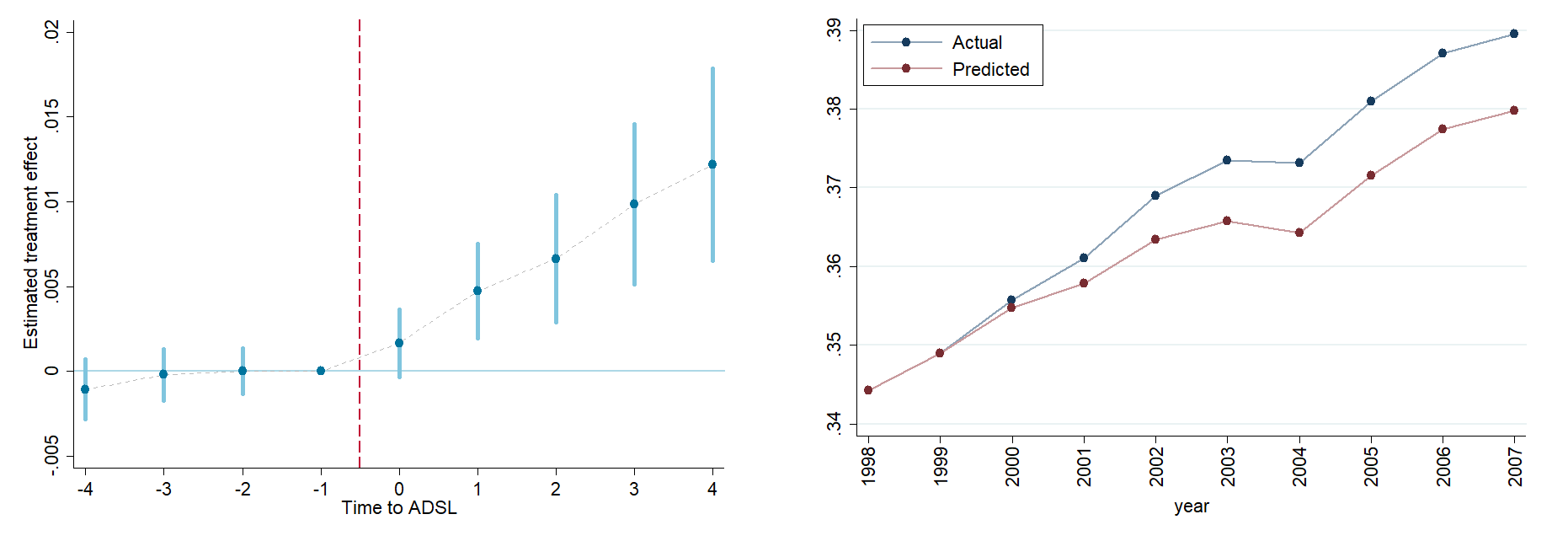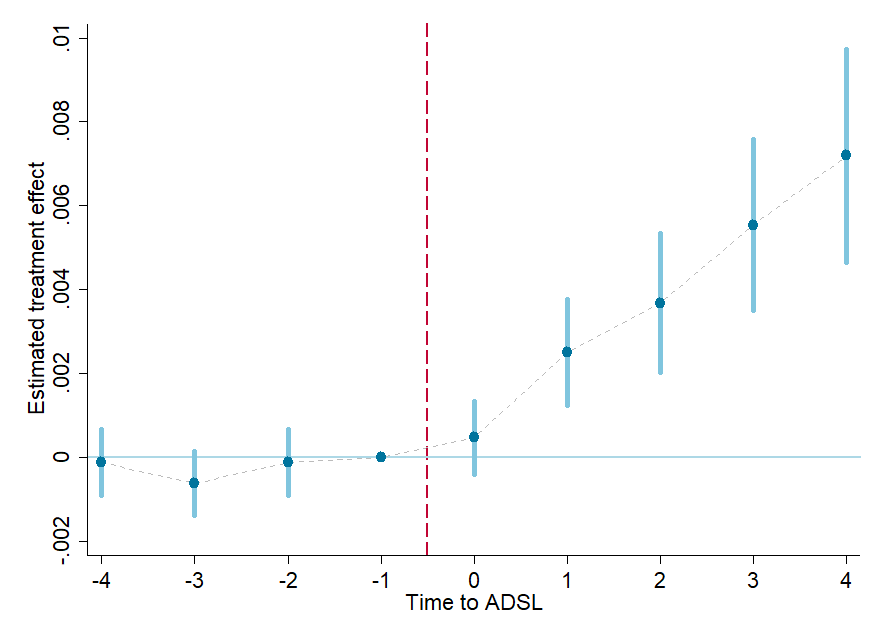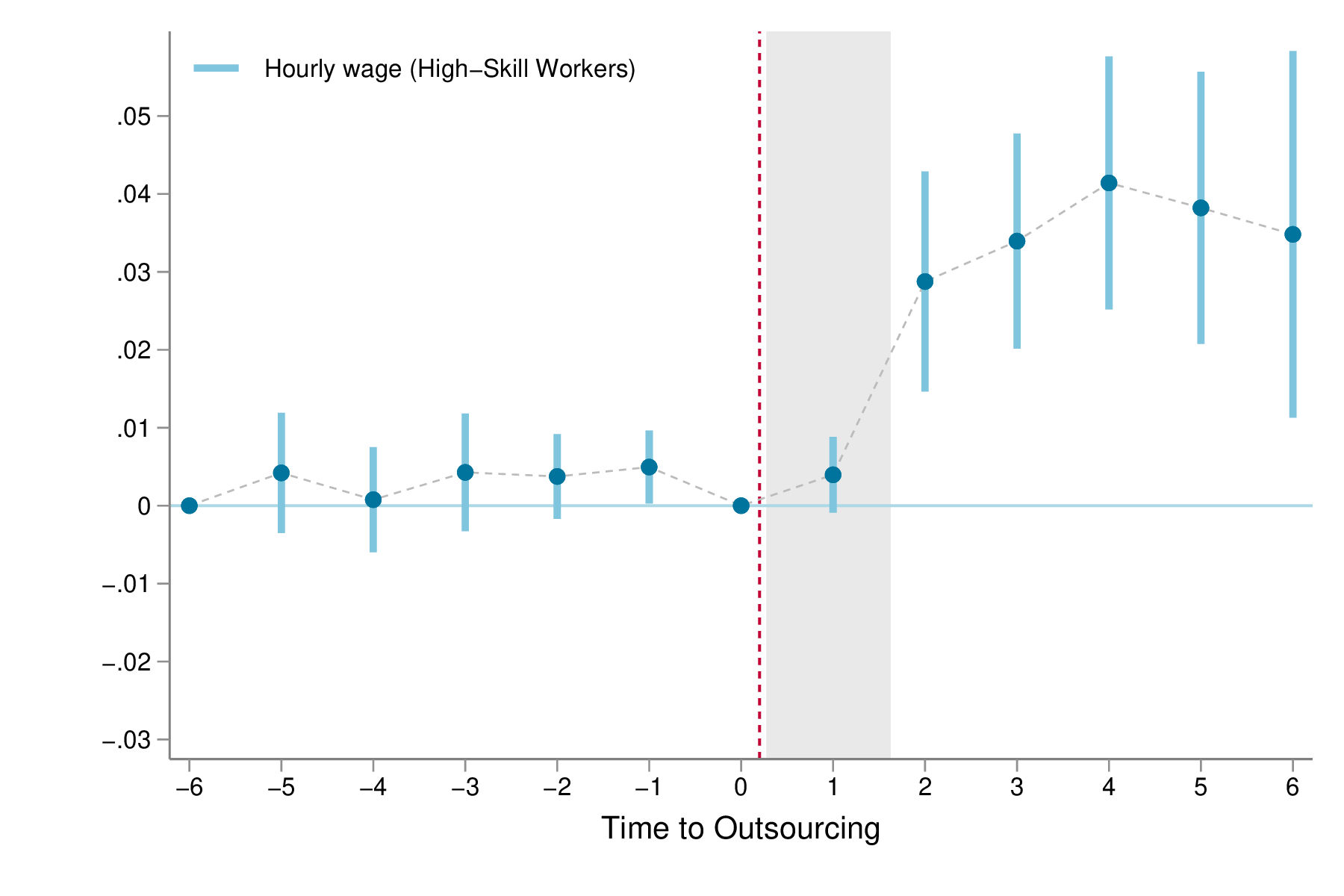Domestic outsourcing has grown substantially in developed countries over the past two decades. One reason for this is technological change that allows work to be done externally. Antonin Bergeaud, Clement Malgouyres, Clement Mazet-Sonilhac and Sara Signorelli show that broadband technology increases firm productivity and the relative demand for high-skilled workers. Both low- and high-skilled workers in non-core occupations were more likely to be outsourced after the arrival of broadband. But only high-skill workers experienced salary gains from being outsourced, while low-skill workers lost out.
In a book published in 2014, “The Fissured Workplace”, David Weil describes the fragmentation of the organisation of firm production, resulting from a growing reliance on outsourcing. Outsourcing is the process whereby a specialised service company now operates an activity that was previously performed in-house. These outsourced activities are as diverse as IT, human resources, accounting, marketing, communication, transport, security and cleaning (see Goldschmidt and Schmieder, 2017 for a description in the German context). Outsourcing results in restructuring companies increasing their focus on their core competencies, i.e., activities directly involved in the production process.
Weil suggests that technological change may be one of the determinants of workplace fragmentation: new information and communication technologies offer numerous possibilities for coordinating and controlling work inside and outside the firm. In a recent article (Bergeaud et al., 2021), we test this hypothesis by studying the effect of technological change on the outsourcing decisions of firms, and further explore the consequences for externalised workers. We do this by leveraging a large-scale technological shock: the progressive roll-out of high-speed broadband internet (BI) in France, from 1999 to 2007.
The roll-out of broadband internet in France
The diffusion of BI has been very gradual. As shown in Figure 1, large urban centres were equipped in the early 2000s, while rural and remote areas had to wait almost 10 additional years. One reason for the gradual deployment of BI is the eligibility of telephone network lines for this new technology. In 2000, only 11 million lines (i.e. 1/3 of the network) could be equipped with BI technology and significant infrastructure investments were required to modernise the remaining two-thirds of the network. Therefore, the gradual roll-out of BI provides an ideal empirical framework for studying the causal impact of this technological shock: the significant spatial and temporal variations in broadband access, even within the same county, make it possible to compare firms that have access (treated firms) with similar firms that do not (control firms).
Figure 1. Gradual deployment of broadband internet in France

Note: This figure presents the geographical distribution of the measure of local broadband availability at the city level in 4 different years. Source: Bergeaud et al. (2021)
The reaction of firms: increasing outsourcing and higher concentration of occupations
Measuring changes in firms’ outsourcing strategies is not easy because external (subcontracted) workers are not generally linked to the firms buying their services in social security data, which is the administrative source most frequently used to study the labour market (in France, the DADS). To get around this methodological difficulty, we used data from the income statements of firms, and in particular the accounting item “personnel expenses outside the firm”. They show that treated firms, i.e., those located in a commune that is connected to BI, have indeed gradually increased their subcontracting expenses. These are 4% higher four years after the connection than in the period before.
According to economic theory, the increase in outsourcing expenses should be accompanied by a restructuring of employment in companies, to refocus on “core” activities. To test this hypothesis, we construct an indicator called the “Herfindhal Index”, which measures the concentration of employees performing the same activities within companies. If this index is close to 0, it means that firms employ workers in a wide variety of activities. On the other hand, if it is close to 1, it indicates that the establishment has a high concentration of employees doing the same activities. Thus, the higher the indicator, the higher the level of task specialisation of the firm.
Figure 2. Broadband internet and concentration of occupations

Note: Left-hand side figure shows the evolution in the concentration index in years surrounding the connection to BI. The right-hand side figure shows the development of this concentration index and the counterfactual development absent the technological shock. Source: Bergeaud et al. (2021)
Figure 2a shows the evolution of this concentration index for firms in cities connected to BI, which confirms that this new technology increases the specialisation of firms in their core skills by about 1.6%. To give an idea of the aggregate magnitude of this change, Figure 2b plots the change in average concentration at the national level as observed in the data (blue curve) and as it would have been without the diffusion of BI (red curve). Concentration, which was already on an upward trend, was significantly accelerated by the access to broadband internet.
What are the consequences for workers?
The economic literature has studied extensively the effects of technological change on wages, reaching a wide consensus regarding what is known as “skill biased technological change”. The intuition is as follows: new technologies tend to substitute tasks previously performed by workers with low levels of education, while they require workers with university degrees to install and program them. They are therefore “biased” in favour of the most skilled individuals. In practice, following a technological change, the demand for skilled workers with technical skills increases, and if labour supply is slow to adjust, then the wages of skilled workers increase as well. On the other hand, low-skilled workers risk being downgraded by the changes introduced by this technology, especially if they do not receive professional training. Formally, this translates into an increase in the wage gap between skilled and unskilled workers. Akerman et al (2015) confirm this effect using the diffusion of broadband internet in Norway: the wage gap between skilled and unskilled workers within the same sector increased because of this technological change.
We confirm these results in the French context, and show that the outsourcing process is a catalyst for the “skilled biased technological change” phenomenon. Figure 3 shows that access to broadband internet has indeed increased the demand for skilled workers in the connected municipalities, which in turn has increased the hourly wage of the average worker by 3%, an average effect that is mostly driven by workers in high-skilled occupations.
Figure 3. Broadband internet and share of high-skill workers in the city

Note: This figure presents the evolution of the share of high skill workers in a city surrounding the connection to Broadband internet. Source: Bergeaud et al. (2021)
What happens to the wages of the outsourced workers? We follow workers after a move to a firm specialising in providing services to other firms, and look at their wages before and after this move. When low-skilled workers, such as cleaners, security personnel or drivers, are outsourced to a service firm, they suffer on average a 1% loss in their wages. On the contrary, high-skilled workers, such as IT specialists or consultants, see their wages increase by 4% on average after moving to the service sector (see Figure 4a and 4b). The fragmentation of work organisation within firms is thus also accompanied by an increase in wage inequality in the labour market.
Figure 4. Wage of outsourced workers before and after the outsourcing event


Note: This figure presents the evolution of the wage of low skill workers (top panel) and high skill workers (bottom panel) after a move to an outsourcing service firm. Source: Bergeaud et al. (2021)
What are the implications for today?
We show that the diffusion of information and communication technologies has a causal effect on the outsourcing and subcontracting of activities considered “peripheral”, as diverse as IT, human resources, accounting, marketing, communication, transport, security or cleaning. This allows companies to restructure and focus on their core business. The consequences for outsourced workers are heterogeneous: while high-skilled workers benefit from this situation, low-skilled workers see their hourly wages decrease. This situation might seem grim for low-skilled workers, who are both directly (through the skill biased technological change) and indirectly (through the fragmentation of the workplace) negatively impacted by technology. In a study using British data, however, Aghion et al. (2019) find that as technology advances, firms outsource some occupations but will continue to value low-skilled workers who have high levels of soft skills
These findings have a particular resonance today: the COVID-19 pandemic has changed the way we work and has triggered a massive adoption of new information and communication technologies. The unprecedented use of telework is a shock that shares many similarities with broadband internet: increased productivity (Barrero et al. 2021) and reduced communication costs, notably thanks to large digital investments. This “shock” could thus lead companies to reorganise and encourage the outsourcing of new activities.
♣♣♣
Notes:
- This blog post is based on “Technological change and domestic outsourcing“, CEP Discussion Paper No 1784 of LSE’s Centre for Economic Performance.
- The post expresses the views of its authors, not the position of LSE Business Review or the London School of Economics.
- Featured image by Mika Baumeister on Unsplash
- When you leave a comment, you’re agreeing to our Comment Policy.





